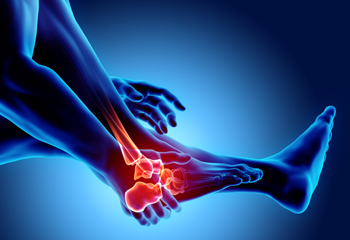Connect With Us
Blog
Can Relief Be Found From Rheumatoid Arthritis?
 Patients who have arthritic flare ups can experience warm sensations in the joints of the feet. They may also feel tired or ill. It can be difficult to move the affected foot as a result of inflamed joint linings. As the aging process occurs, this condition can be caused by gradual deterioration of the joints while patients complete daily activities. Mild relief may be found when specific stretches and exercises are performed, in addition to taking pain-relieving medication. If you or a loved one has pain and stiffness in the joints of the feet, it is strongly suggested that you consult with a podiatrist who can effectively treat this condition.
Patients who have arthritic flare ups can experience warm sensations in the joints of the feet. They may also feel tired or ill. It can be difficult to move the affected foot as a result of inflamed joint linings. As the aging process occurs, this condition can be caused by gradual deterioration of the joints while patients complete daily activities. Mild relief may be found when specific stretches and exercises are performed, in addition to taking pain-relieving medication. If you or a loved one has pain and stiffness in the joints of the feet, it is strongly suggested that you consult with a podiatrist who can effectively treat this condition.
Because RA affects more than just your joints, including the joints in your feet and ankles, it is important to seek early diagnosis from your podiatrist if you feel like the pain in your feet might be caused by RA. For more information, contact one of our podiatrists of Foot & Ankle Associates of Maine. Our doctors will assist you with all of your podiatric concerns.
What Is Rheumatoid Arthritis?
Rheumatoid Arthritis (RA) is an autoimmune disorder in which the body’s own immune system attacks the membranes surrounding the joints. Inflammation of the lining and eventually the destruction of the joint’s cartilage and bone occur, causing severe pain and immobility.
Rheumatoid Arthritis of the Feet
Although RA usually attacks multiple bones and joints throughout the entire body, almost 90 percent of cases result in pain in the foot or ankle area.
Symptoms
- Swelling and pain in the feet
- Stiffness in the feet
- Pain on the ball or sole of feet
- Joint shift and deformation
Diagnosis
Quick diagnosis of RA in the feet is important so that the podiatrist can treat the area effectively. Your doctor will ask you about your medical history, occupation, and lifestyle to determine the origin of the condition. Rheumatoid Factor tests help to determine if someone is affected by the disease.
If you have any questions please feel free to contact our office located in Brunswick, ME . We offer the newest diagnostic and treatment technologies for all your foot and ankle needs.
Is Toenail Fungus Common?
 A fungal infection of the toenails is known as onychomycosis, and it is considered to be contagious. Toenail fungus often affects up to ninety percent of elderly people. The type of fungus that causes this ailment lives and thrives in warm and moist environments. These can consist of public swimming pools, shower room floors, and surrounding areas. It is beneficial to wear appropriate shoes while in these places, and this may help to control outbreaks of toenail fungus. Common symptoms that are typically associated with this condition can include a thickening and yellowing of the toenails, often starting with the big toe. In severe cases, the nail may become brittle and lift off of the nail bed. If you have toenail fungus, please confer with a podiatrist who can recommend correct treatment options for you.
A fungal infection of the toenails is known as onychomycosis, and it is considered to be contagious. Toenail fungus often affects up to ninety percent of elderly people. The type of fungus that causes this ailment lives and thrives in warm and moist environments. These can consist of public swimming pools, shower room floors, and surrounding areas. It is beneficial to wear appropriate shoes while in these places, and this may help to control outbreaks of toenail fungus. Common symptoms that are typically associated with this condition can include a thickening and yellowing of the toenails, often starting with the big toe. In severe cases, the nail may become brittle and lift off of the nail bed. If you have toenail fungus, please confer with a podiatrist who can recommend correct treatment options for you.
For more information about treatment, contact one of our podiatrists of Foot & Ankle Associates of Maine. Our doctors can provide the care you need to keep you pain-free and on your feet.
Toenail Fungus Treatment
Toenail fungus is a condition that affects many people and can be especially hard to get rid of. Fortunately, there are several methods to go about treating and avoiding it.
Antifungals & Deterrence
Oral antifungal medicine has been shown to be effective in many cases. It is important to consult with a podiatrist to determine the proper regiment for you, or potentially explore other options.
Applying foot powder on the feet and shoes helps keep the feet free of moisture and sweat.
Sandals or open toed shoes – Wearing these will allow air movement and help keep feet dry. They also expose your feet to light, which fungus cannot tolerate. Socks with moisture wicking material also help as well.
If you have any questions please feel free to contact our office located in Brunswick, ME . We offer the newest diagnostic tools and technology to treat your foot and ankle needs.
Tips for Happy Feet
 Your feet support your weight and help you move throughout the day. Taking care of your feet can play a big role in maintaining your overall health. One of the most important aspects of good foot care is making sure that the shoes you wear are comfortable, supportive, and properly fitted. The right shoes can prevent a variety of painful injuries and foot conditions. Look for shoes that protect, cushion, and support your feet, and avoid shoes like flip flops, which are often flimsy and can increase your risk of foot pain. Proper hygiene is an important part of foot health as well. Wash and thoroughly dry your feet daily to avoid fungal infections, and trim your toenails straight across and not too short to help prevent ingrown nails. For more tips on everyday foot care, it is suggested that you consult with a podiatrist.
Your feet support your weight and help you move throughout the day. Taking care of your feet can play a big role in maintaining your overall health. One of the most important aspects of good foot care is making sure that the shoes you wear are comfortable, supportive, and properly fitted. The right shoes can prevent a variety of painful injuries and foot conditions. Look for shoes that protect, cushion, and support your feet, and avoid shoes like flip flops, which are often flimsy and can increase your risk of foot pain. Proper hygiene is an important part of foot health as well. Wash and thoroughly dry your feet daily to avoid fungal infections, and trim your toenails straight across and not too short to help prevent ingrown nails. For more tips on everyday foot care, it is suggested that you consult with a podiatrist.
Everyday foot care is very important to prevent infection and other foot ailments. If you need your feet checked, contact one of our podiatrists from Foot & Ankle Associates of Maine. Our doctors can provide the care you need to keep you pain-free and on your feet.
Everyday Foot Care
Often, people take care of their bodies, face and hair more so than they do for their feet. But the feet are a very important aspect of our bodies, and one that we should pay more attention to. Without our feet, we would not be able to perform most daily tasks.
It is best to check your feet regularly to make sure there are no new bruises or cuts that you may not have noticed before. For dry feet, moisturizer can easily be a remedy and can be applied as often as necessary to the affected areas. Wearing shoes that fit well can also help you maintain good foot health, as well as making it easier to walk and do daily activities without the stress or pain of ill-fitting shoes, high heels, or even flip flops. Wearing clean socks with closed shoes is important to ensure that sweat and bacteria do not accumulate within the shoe. Clean socks help to prevent Athlete’s foot, fungi problems, bad odors, and can absorb sweat.
If you have any questions please feel free to contact our office located in Brunswick, ME . We offer the newest diagnostic and treatment technologies for all your foot and ankle needs.

